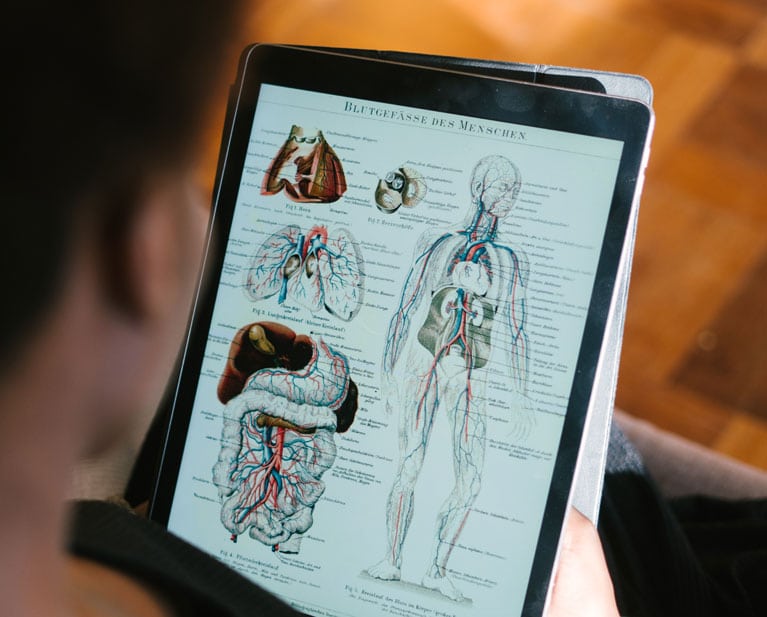When I was in physical therapy school, a full semester was dedicated to dissecting a human cadaver to better appreciate the musculoskeletal relationships and complexities within the body. To fully visualize the muscle connections, nerve pathways and joints, we spent hours pulling away other tissue that surrounded these structures. One of the main tissues we would discard was the fascia. And while we learned about the existence of fascia, it was seen more as a passive structure that just surrounded or connected muscles within the body.
Today, scientists now recognize the extensive role that the fascia has within the body and are spending more time studying its many functions. We now know that fascia isn’t just some passive tissue that helps hold things together; it is actually a dynamic system that permeates and influences everything within the body down to the cellular level, rivaling the importance of other body systems like circulatory and nervous systems. (1)
So now that fascia is receiving more recognition, let’s talk more about its importance.
What is Fascia?
Fascia is a network of connective tissue that takes place through the entire body. Imagine flexible web-like scaffolding that binds every cell in the body to its neighbors; fascia is the fabric of the body that keeps us from ending up as a puddle on the floor (2)
What Does Fascia Do?
1. Distribute Forces
Fascia creates vectors of tension that distribute the load and helps the body move. To illustrate this, think of the biceps. Traditionally, you may think that when the biceps contract, it moves its two points of skeletal attachments closer together, allowing you to bend your elbow. But in reality, during an elbow bend, up to half of that power is going to the connective tissue around the biceps to create the movement. (3)
2. Relay Information
The fascial system is a whole-body communicating network. With every change in pressure and tension on the body, the fascial generates bioelectric signals of information. This information allows the fascia to change as needed in response to the forces placed on the body (2).
3. Heal the Body
Fascia contains all the building blocks necessary to our structure and movement (2). One important component of fascia that aids in healing is a protein called collagen. The collagen and other elemental structures can spontaneously arrange in different proportions and arrays depending on the needs and function of a particular body part. The versatile and responsive nature of this collagenous network enables fascia to create new and differentiated tissue in response to injury. (2)
Fascia Restrictions
Envision the building blocks of this fascia webbing to be like fruit jello. Fascia is made of a matrix of water-loving chemicals, creating a ground substance (jello) that keeps the fascia plump and juicy and gives space between the proteins (fruit) so they can move freely. If the proteins within the fascia get too crowded, they tend to stick together like glue; if they stay that way, they become a scar.
Some of the most common mechanisms of negative impact and injury to the fascia include:
- Microtrauma: repetitive overload
- Macrotrauma: strains, sprains, contusions
- Mechanical: poor posture, inefficient ergonomics, scoliosis
- Neurological: nerve sensitivities, spastic muscles, nerve compression
- Physiological: Inflammation, pH changes, elevation of some hormones like cortisol
How Does PT Help?
Physical therapists typically focus on the fascia that surrounds the muscles known as myofascia. Through the application of a variety of manual techniques or specialized movements, therapists can cause physiological changes to the fascial tissue to help restore fluid flow, muscle function, and the connection with the sensory-motor system. They are able to facilitate an easing of the biomechanical pull that caused the increased stress on that tissue in the first place. (2) Myofascial release techniques performed by physical therapists have several positive results, including improved muscle relaxation, better circulation, reduced inflammation, better posture, improved range of motion, and decreased pain.
The trained physical therapists at SetPT have a myriad of techniques they use to improve patients’ physical wellbeing. Reach out today to set up a movement assessment!
Sources:
1. https://fasciacongress.org/congress/about-fascia/
2. Myers, Thomas W. Anatomy Trains. London: Urban & Fischer; 2011.
3. Huijing P, et al. Fascia Research II. Munich: Urban & Fischer; 2009





